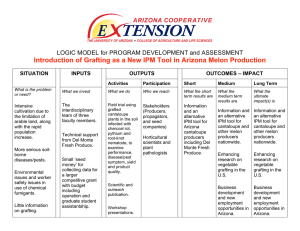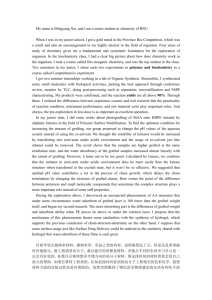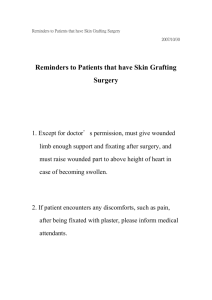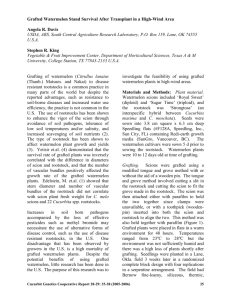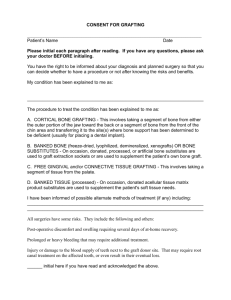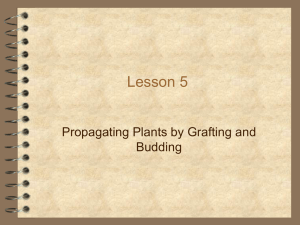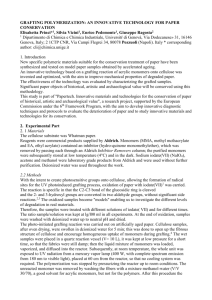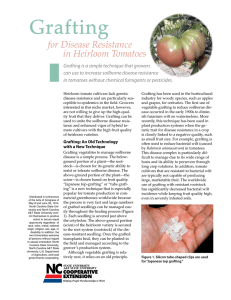Grafting Vegetables
advertisement
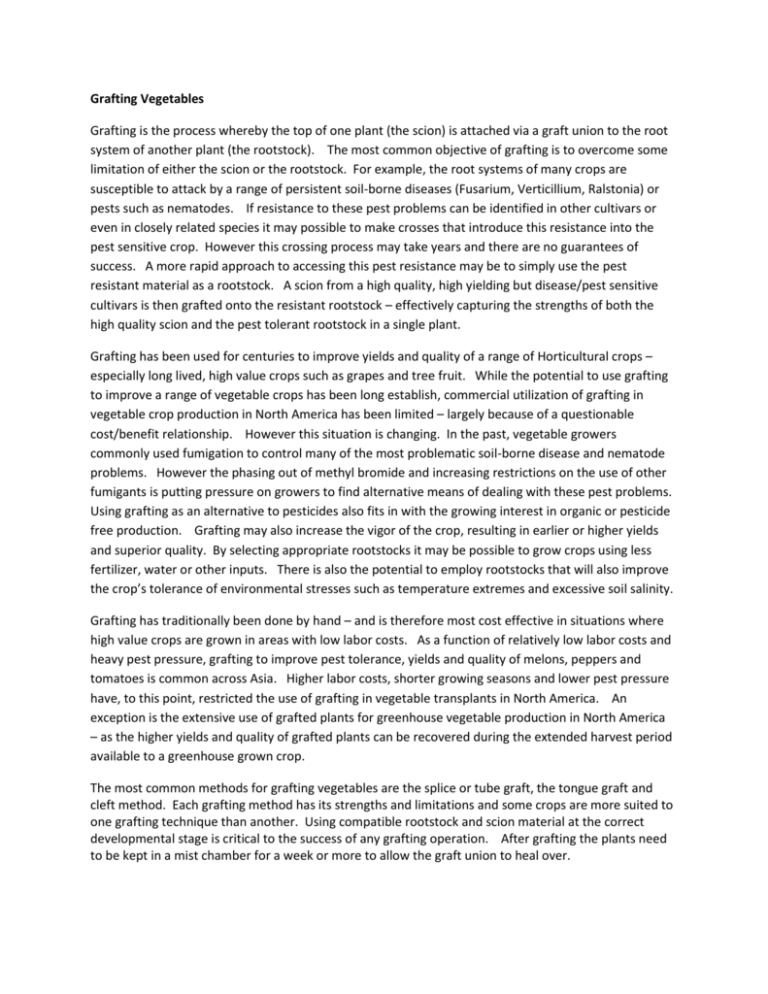
Grafting Vegetables Grafting is the process whereby the top of one plant (the scion) is attached via a graft union to the root system of another plant (the rootstock). The most common objective of grafting is to overcome some limitation of either the scion or the rootstock. For example, the root systems of many crops are susceptible to attack by a range of persistent soil-borne diseases (Fusarium, Verticillium, Ralstonia) or pests such as nematodes. If resistance to these pest problems can be identified in other cultivars or even in closely related species it may possible to make crosses that introduce this resistance into the pest sensitive crop. However this crossing process may take years and there are no guarantees of success. A more rapid approach to accessing this pest resistance may be to simply use the pest resistant material as a rootstock. A scion from a high quality, high yielding but disease/pest sensitive cultivars is then grafted onto the resistant rootstock – effectively capturing the strengths of both the high quality scion and the pest tolerant rootstock in a single plant. Grafting has been used for centuries to improve yields and quality of a range of Horticultural crops – especially long lived, high value crops such as grapes and tree fruit. While the potential to use grafting to improve a range of vegetable crops has been long establish, commercial utilization of grafting in vegetable crop production in North America has been limited – largely because of a questionable cost/benefit relationship. However this situation is changing. In the past, vegetable growers commonly used fumigation to control many of the most problematic soil-borne disease and nematode problems. However the phasing out of methyl bromide and increasing restrictions on the use of other fumigants is putting pressure on growers to find alternative means of dealing with these pest problems. Using grafting as an alternative to pesticides also fits in with the growing interest in organic or pesticide free production. Grafting may also increase the vigor of the crop, resulting in earlier or higher yields and superior quality. By selecting appropriate rootstocks it may be possible to grow crops using less fertilizer, water or other inputs. There is also the potential to employ rootstocks that will also improve the crop’s tolerance of environmental stresses such as temperature extremes and excessive soil salinity. Grafting has traditionally been done by hand – and is therefore most cost effective in situations where high value crops are grown in areas with low labor costs. As a function of relatively low labor costs and heavy pest pressure, grafting to improve pest tolerance, yields and quality of melons, peppers and tomatoes is common across Asia. Higher labor costs, shorter growing seasons and lower pest pressure have, to this point, restricted the use of grafting in vegetable transplants in North America. An exception is the extensive use of grafted plants for greenhouse vegetable production in North America – as the higher yields and quality of grafted plants can be recovered during the extended harvest period available to a greenhouse grown crop. The most common methods for grafting vegetables are the splice or tube graft, the tongue graft and cleft method. Each grafting method has its strengths and limitations and some crops are more suited to one grafting technique than another. Using compatible rootstock and scion material at the correct developmental stage is critical to the success of any grafting operation. After grafting the plants need to be kept in a mist chamber for a week or more to allow the graft union to heal over. Published costs for producing grafted vegetables seedlings vary greatly – as a function of the efficiency of the grafting operation, the basic cost of plant materials and labor costs. Grafting tomatoes by hand increased the cost of each plant by 100 to 400% (Besri, 2003; Rivard et al., 2010). While the additional cost associated with using grafted plants is substantial – the actual cost per unit area of using grafted plants is comparable to the cost of fumigating (Kubota et al., 2008). This cost/benefit balance also appears to be shifting in favor of using grafted plants – as the cost of fumigants is increasing rapidly while restrictions on their use are becoming extremely stringent. With increasing grower experience and economies of scale, the cost of production of grated vegetable seedlings will decline – especially if efforts to develop and commercialize mechanical grafting systems prove fruitful. Sources Besri (2003). Tomato grafting as an alternative to fumigation in Morocco. http://mboa.org/2003/012%20besrimgraftingmbao2003sd.pdf. Kubota et al. (2008). Vegetable Grafting - history, use and current technology status in North America. HortScience 43: 1664-1669. Rivard et al. (2010). An economic analysis of two grafted tomato transplant production systems in the United States.
